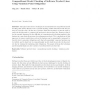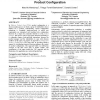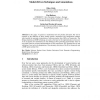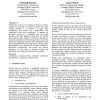114
click to vote
TSE
2010
14 years 7 months ago
2010
Recent advances in mechanical techniques for systematic testing have increased our ability to automatically find subtle bugs, and hence to deploy more dependable software. This pap...
194
click to vote
ASE
2011
14 years 7 months ago
2011
This paper introduces a technique for incremental and compositional model checking that allows efficient reuse of model-checking results associated with the features in a product l...
122
click to vote
VAMOS
2010
Springer
14 years 11 months ago
2010
Springer
Abstract—Today, software product line engineering concentrates on tailoring the functionality of programs. However, we and others observed an increasing interest in non-functiona...
136
click to vote
SOSYM
2010
14 years 11 months ago
2010
Model driven development (MDD) of software product lines (SPLs) merges two increasing important paradigms that synthesize programs by transformation. MDD creates programs by transf...
132
click to vote
SAC
2008
ACM
15 years 6 days ago
2008
ACM
In Software Product Lines (SPLs), product configuration is a decision-making process in which a group of stakeholders choose features for a product. Unfortunately, current configu...
120
Voted
JUCS
2008
15 years 21 days ago
2008
: In this paper, we present a model-based tool for product derivation. Our tool is centered on the definition of three models (feature, architecture and configuration models) which...
106
Voted
ENTCS
2006
15 years 22 days ago
2006
In the domain of embedded software systems the increasing complexity of the functionality as well as the increase in variations caused by product lines requires a modular design p...
125
click to vote
CORR
2010
Springer
15 years 25 days ago
2010
Springer
This article is about a measurement analysis based approach to help software practitioners in managing the additional level complexities and variabilities in software product line...
115
Voted
SPLC
2007
15 years 1 months ago
2007
Product lines need decision models that guide the derivation of product variants satisfying specific requirements. In dynamic product lines, whose requirements vary during runtime...
118
click to vote
WICSA
2001
15 years 2 months ago
2001
Product lines evolve out of existing products. In order to evaluate the potential of creating a product line from existing products it is necessary to `mine' their architectu...





